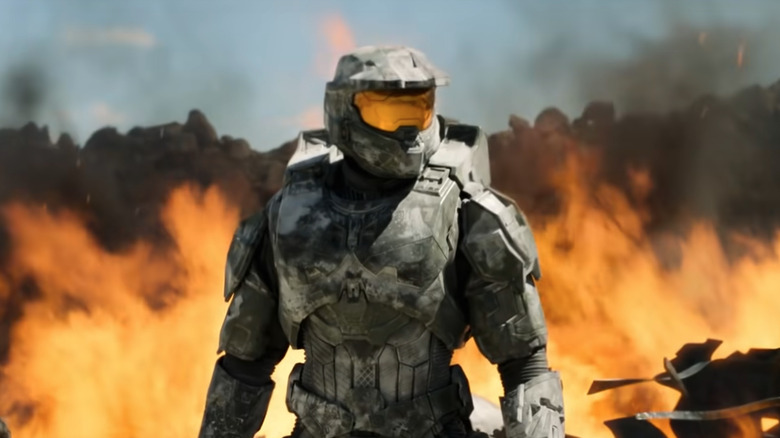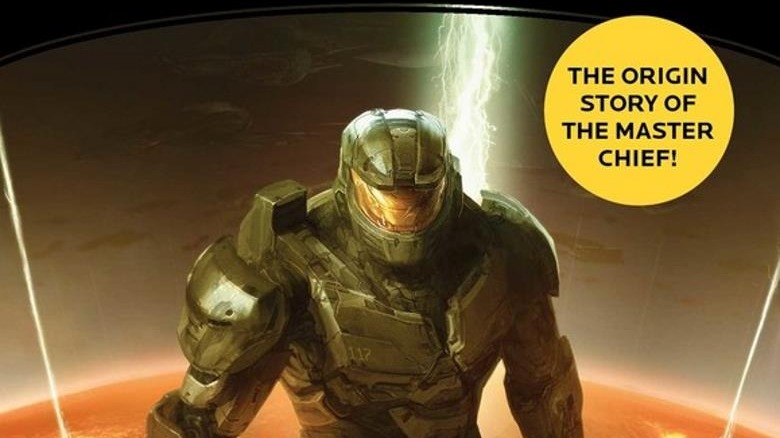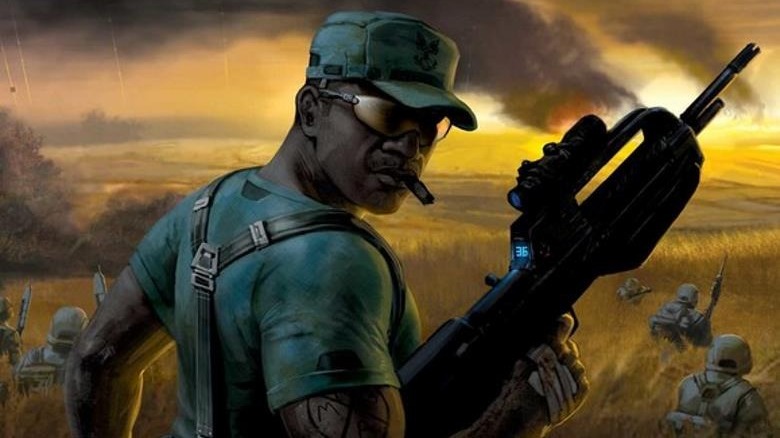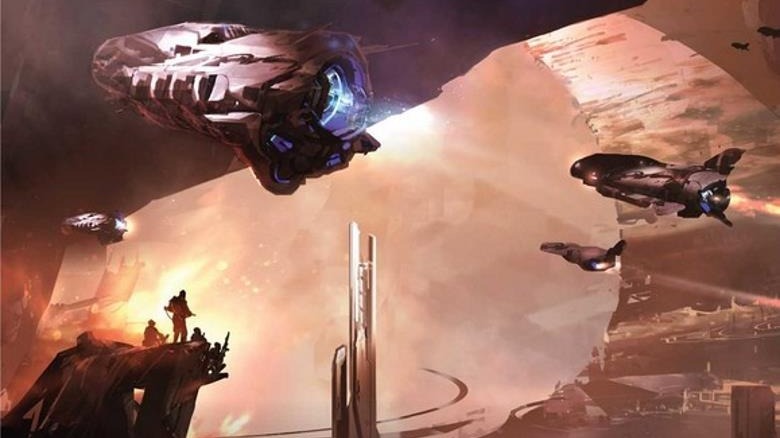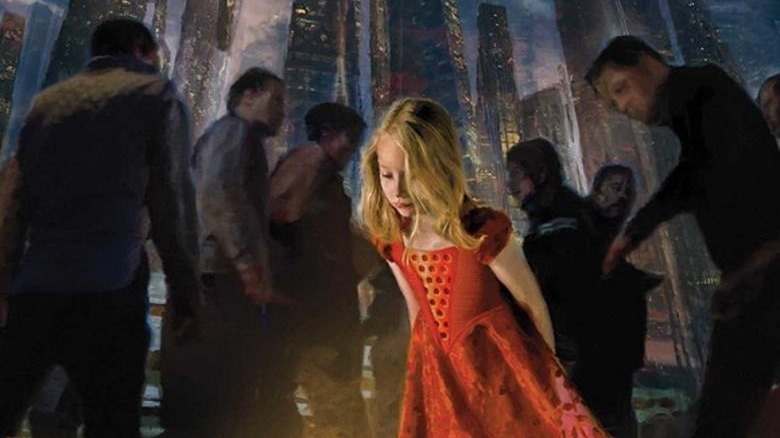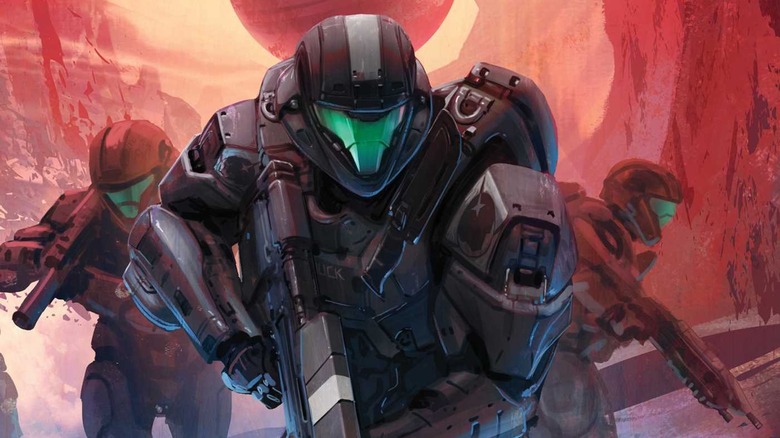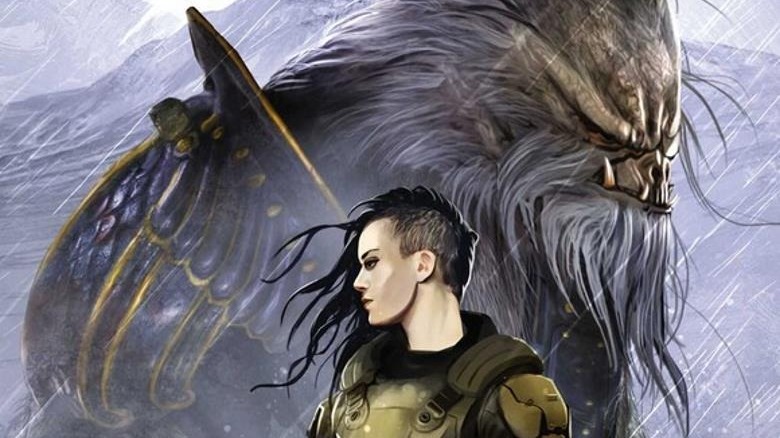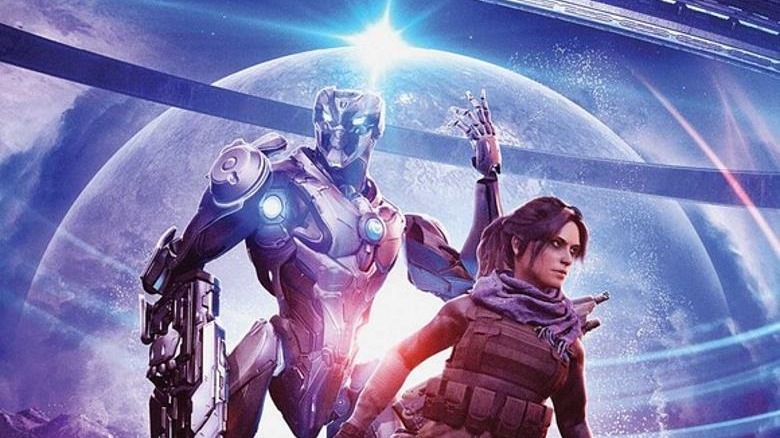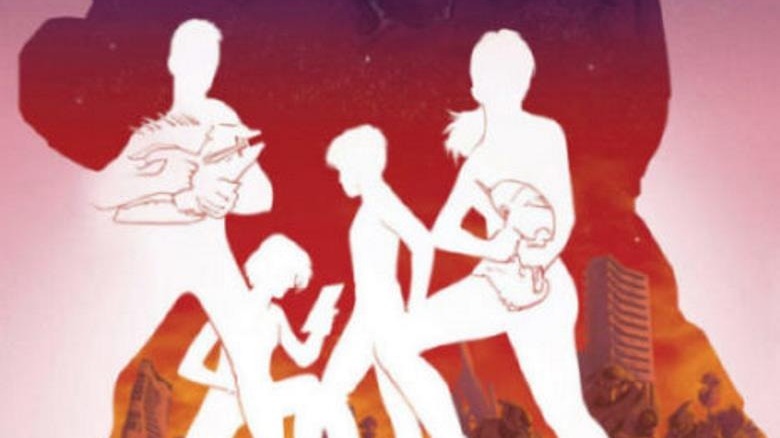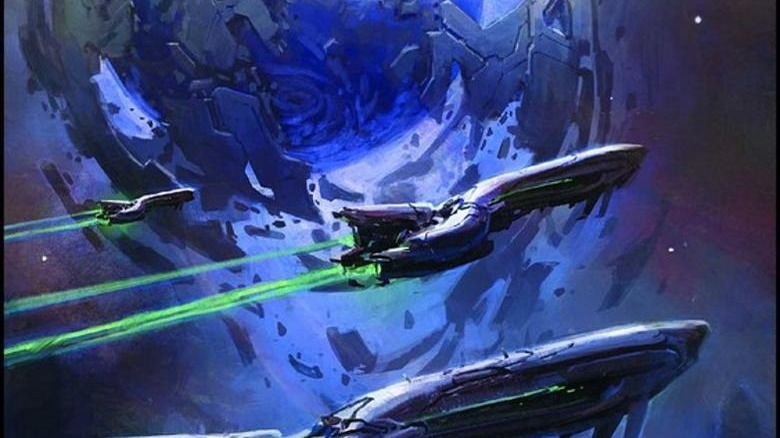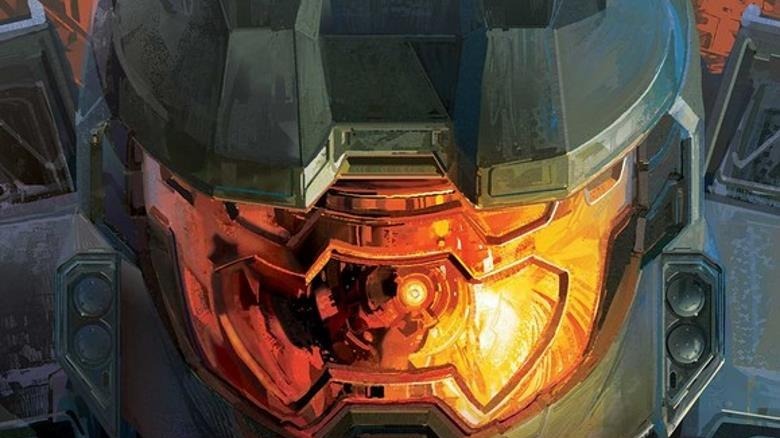The Proper Reading Order For The Halo Books
"Halo" is a story about a super soldier known as Master Chief (aka John-117) who fights aliens in space over ancient technology. You might think from the description that it's a story you've seen many times before. Certainly, "Halo" wears its influences on its sleeve. But don't underestimate the world of the games, which has thus far been the subject of over 30 novels, several comics, and one season of a live-action television show. Bungie cut their teeth directing the "Marathon" trilogy of narratively ambitious first-person shooters. "Halo" was targeted at a wider audience, but its developers still took the time to flesh out the game's setting. Rather than the heavy metal mishmash of "Doom" and its ilk, this would be a world of alien religious sects, military jargon, and Gregorian chanting.
Ed Fries, who ran Microsoft Game Studios at the time the first "Halo" was released, said in Vice's oral history of the series that "'Halo' is about winning the battle but losing the war." The power fantasy of Master Chief is heightened further by humanity's continuing losses against the villainous Covenant. The first book in the series, "Halo: The Fall of Reach," was published a month before the release of the first "Halo" game. Setting expectations, it ends with a massacre. Following titles in the series continued to poke and prod at the expectations of readers, featuring a rotating cast of writers. Some were behind-the-scenes architects of the "Halo" games themselves. Others were strangers. All left their mark.
Where to begin reading the Halo books
A curious reader may wonder where to begin reading books set in the world of "Halo." Should they begin with the first books published? Or should they proceed in chronological order, tackling books that take place 100,000 years before the events of the games? Thankfully, the publisher Del Rey has made things easy for us. In 2004, they released a box set featuring the first three "Halo" books: "The Fall of Reach," "The Flood," and "First Strike." They were all published before the release of "Halo 2" that year.
Of the three, the most important is without a doubt "Halo: The Fall of Reach" (published October 30, 2001). Written by Eric Nylund, the man who named Master Chief John, "The Fall of Reach" fleshes out the SPARTAN-II super-soldier program and introduces its creator, the infamous Dr. Catherine Halsey. It ends with a disastrous battle that sets the life-or-death stakes of the first "Halo" game. The story of "Reach" has been retold across comics, an animated series, and even a video game that made significant changes to Nylund's story. But "The Fall of the Reach" was the first attempt and is thus historically important. Nylund returned to the "Halo" universe to write "First Strike" (published December 2, 2003), a bridge between the events of "Halo" (with a nod to "Fall of Reach") and the still-in-development "Halo 2."
Between the two novels is "The Flood" (published April 1, 2003), a novelization of "Halo" by William C. Dietz. I recommend playing the game for a more authentic experience, but if you're a completionist, it's here!
The second box set
Tor released a box set collecting the next three books in the series, the next stop along our reading journey. Unlike the previous set, which primarily featured Eric Nylund's take on the series, each book in the second box set was written by a different author. Nylund wrote "Ghosts of Onyx" (published October 31 2006), a sequel to "Halo 2" and "First Strike." With "Halo 3" in sight, Bungie kept a tighter leash on Nylund than usual. "Ghosts of Onyx" keeps Master Chief to the sidelines and follows a new generation of SPARTAN-III super soldiers. The book is well liked by fans, but Nylund has yet to return to the world of "Halo" — perhaps he was tired of writing to Bungie's specifications.
The second book in the set, Joseph Staten's "Contact Harvest" (published October 30, 2007), detailed the first encounter between humanity and the Covenant through the eyes of Master Chief's friend Avery Johnson. According to Vice's oral history, he co-developed the religious motivations of the Covenant, introduced the voice actress behind Master Chief's AI helper Cortana to the team, and brainstormed ways to give the in-game grunts personality. "Contact Harvest" is the only full-length novel Staten has written in the "Halo" universe and is thus canonical reading. It's also pretty good, and it features the first sex scene in a piece of "Halo" media.
Finally, Tobias Buckell's "The Cole Protocol" (published November 5, 2008) introduced a trio of rough-and-tumble SPARTAN-IIs called Gray Team. Just as "Contact Harvest" fleshes out Avery Johnson, "Cole Protocol" includes another character killed off in the first "Halo," Jacob Keyes. Buckell edited the first "Halo Encyclopedia," published in 2009. Nearly a decade later, he continued the adventures of Gray Team in the novel "Envoy" (published April 25, 2017).
The Forerunner Saga
The extended "Halo" universe took a break between the release of "Halo Wars" in 2009 and "Halo ODST" in 2010, with a notable exception we shall profile below. In 2011, the dam broke. Two trilogies began serialization, the first taking place 100,000 years in the past and the second following the events of "Halo 3." For the purposes of chronology, let's begin with the first: Greg Bear's "Forerunner Saga." Bear is an accomplished science fiction writer in his own right, famous for the novella "Blood Music," which imagines an intelligent, humanity-warping pandemic. While he isn't particularly accomplished as a stylist, he's a reliable craftsman of Big Ideas, and a fantastic get for "Halo" tie-in fiction.
Like you'd expect from the title, the "Forerunner Saga" (published in volumes January 4, 2011, January 3, 2012 and March 19, 2013) fleshes out the titular aliens who built the giant ring-shaped Halo devices. The books shift genre away from the military fiction of Eric Nylund and Joseph Staten and toward high-concept science fiction loaded with proper nouns. Plenty of "Halo" fans don't know quite what to do with the series, which portrays the Forerunners very differently than they ever appeared in the games. But then, 343 Industries (the stewards of the "Halo" games beginning with "Halo 4") reportedly had long conversations with Bear beforehand, according to quotes from Gizmodo. While Bear came to the project as a hired hand rather than a fan, 343 Industries took care to integrate details from his work into the concurrently developed "Halo 4."
The Kilo-Five trilogy
The "Kilo-Five" trilogy, written by Karen Traviss, is the opposite of the "Forerunner Saga" in many respects. Bear is a big-picture science fiction writer who is at his best when grappling with big ideas. Traviss, on the other hand, is a military science fiction writer most comfortable exploring moral ambiguity in wartime. "There's also huge unexplored depth, gray areas, and really uncomfortable moral dilemmas that underpin the 'Halo' story," she said in a quote provided by Tor Books. "That's like catnip to a writer like me."
The "Kilo-Five" books (published October 25 2011, October 2, 2012 and January 25, 2014) were the first to take place after the events of "Halo 3," and they immediately complicate the simple good versus evil narrative of the games. They also pick up threads Eric Nylund left behind after "Ghosts of Onyx."
"Kilo-Five" has inspired mixed reactions across the "Halo" fandom. On one hand, some longtime fans strongly dislike Traviss' take on the series and reject her interpretation of characters like Dr. Catherine Halsey. On the other hand, former Polygon critic and video man Brian David Gilbert named the "Kilo-Five" trilogy as his favorite of the "Halo" books after reading through them all for "Unraveled." "This trilogy finally explores the ramifications of the lore set up in the first novel," he says, "And it rules." Either way, "Kilo-Five" and "The Forerunner Saga" together mark a creatively fruitful period for "Halo," expanding the scope of the series from its early beginnings.
New Blood and Bad Blood
After the first three "Halo" games, Bungie decided to experiment with the noir-influenced "Halo: ODST." A side-story taking place during and after the events of "Halo 2," the game was directed by our friend and writer of "Contact Harvest" Joseph Staten. Video game critic Gene Park went so far as to describe "ODST" as "the 'Halo' story with the most soul." While the game stands alone, Matt Forbeck (tie-in fiction writer and tabletop role-playing game developer) was hired to write a sequel novella that was published on March 2, 2015.
"New Blood" was the first novella to be published in the "Halo" setting, and it followed the adventures of the Alpha-Nine squad, last seen in "ODST." It was the first book in the series to be made available exclusively as an e-book before its print edition in 2016. "New Blood" is a slight read at 208 pages, but it earned its infamy among the broader fandom by killing off one of the central characters of "ODST" halfway through. It was followed on June 26, 2018 by "Bad Blood," a full-length novel continuing the adventures of the Alpha-Nine squad after the events of "Halo 5." Forbeck's evolution from novella writer to full-length novelist was repeated by future authors in the "Halo" universe, as we shall see.
Into the Denningverse
Up to this point, the standard "Halo" approach for tie-in authors was to write their duology or trilogy of novels, and then to get out. Now we meet Troy Denning, who has written six "Halo" novels to date. Denning is an old hand at tie-in fiction, with an affinity for novels set in tabletop settings like Dark Sun and the Forgotten Realms. He's also a prolific writer in the "Star Wars" setting, where he shared the field with Traviss through the 2000s.
Denning made his start in the "Halo" world with "Last Light" (published September 15, 2015). Rather than military science fiction or hard sci-fi, Denning gives us a murder mystery. Fans of old-school detective novels may be frustrated by how early "Last Light" spills the beans, but then, the mystery is really just a setup for classic odd couple sparring between inspector Veta Lopis and SPARTAN-II Fred-104. The end sees Veta inducted into a black-ops Ferret team, leading to further investigation and skullduggery in Denning's follow-ups "Retribution" (published August 29, 2017) and "Divine Wind" (published October 19, 2021).
Aside from Veta's story, Denning gave us a complete trilogy starring Master Chief. The "Master Chief Story" trilogy, beginning with "Silent Storm" (published September 24, 2018) returns to the military science fiction of "Fall of Reach." "Silent Storm" and its sequel "Oblivion" (September 24, 2019) flesh out Master Chief's earlier battles against the Covenant 20-odd years before the events of the first "Halo." Meanwhile, "Shadows of Reach" (published October 20, 2020) jumps ahead to follow the adventures of Master Chief and company in the aftermath of "Halo 5." Between Veta and his Master Chief novels, Denning has arguably done as much as any author since Eric Nylund to build the status quo of modern "Halo" novels.
Rion Forge and the Ace of Spades
Science fiction fans love a ragtag group of oddballs traveling the galaxy in a rickety spaceship and getting into trouble. Earlier "Halo" novels have gestured at the dynamic, but it is Kelly Gay's novella "Smoke and Shadow" (published November 28, 2016) that evokes the stories most explicitly. According to an interview, Gay realized partway through writing "Smoke and Shadow" that her draft had as much to do with "Firefly" as it did with "Halo." Rather than change gears, she chose to lean into it. "Smoke and Shadow" also embodies the geekiness of tie-in fiction in that heroine Rion Forge is connected to the "Halo" lore not by a mainline title, but by an infamous missing ship from the real-time strategy title "Halo Wars."
Gay followed her novella with two full-length novels featuring the same set of characters, "Renegades" (published February 19, 2019) and "Point of Light" (published March 2, 2021). As the series continues, it ropes in elements from Greg Bear's "Forerunner Saga," paying off characters and storylines laid down nearly a decade ago. But her newest work, "The Rubicon Protocol" (published August 9, 2022), breaks from the adventures of Rion Forge and her crew to craft a stand-alone narrative that ties into "Halo Infinite." Before her "Halo" work, Kelly was best known for her well-liked Kelly Madigan urban fantasy series as well as a number of young adult novels. If she continues along this path, she may stand toe to toe with Troy Denning as the defining modern writer of "Halo" fiction.
The young adult novels
Despite their Mature rating by the Entertainment Software Rating Board, "Halo" games are broadly popular with young teenagers. So it's surprising that it took until 2019 for a "Halo" book to be marketed as "young adult." Cassandra Rose Clarke's "Battle Born" (published January 1, 2019) tells the story of four teenagers stuck in the middle of a Covenant invasion. These are not battle-hardened soldiers, private detectives, or brilliant scientists, but children in way over their heads. Their only hope of survival is each other, and the assistance of a SPARTAN soldier who happens to be in the right place at the right time. Clark followed "Battle Born" with "Meridian Divide" (published October 1, 2019), in which the teens return to their old hometown for a reconnaissance mission.
The majority of "Halo" novels are about military escapades, political intrigue, and big-picture science fiction. The emphasis on the lives of civilians in "Battle Born" is a great change of pace, giving readers a chance to see how ordinary people live in a world that is not built for them. Yet the third book in the series was canceled by the publisher, leaving the series incomplete. So what happened? While I can't prove it, I suspect the answer is the kids and teens who buy and read young adult novels were reading the standard "Halo" novels already. In any case, Clarke is still writing; readers curious about her output should seek out her 2022 novel from Erewhon Books,"The Beholden."
The stand-alones
While the majority of "Halo" books are composed in duologies and trilogies, some stand alone. Joseph Staten's "Contact Harvest," mentioned earlier in this piece, was the first. The next stand-alone novel would not appear until November 14, 2014, when John Shirley (of The Screaming Geezers) wrote "Broken Circle." Taking place hundreds of years before the original "Halo" games, "Broken Circle" focuses on the early history of the Covenant and the Great Schism that permanently changed its makeup. No other novel in the "Halo" universe tackles the subject matter in such depth, making the title essential reading for the Covenant-curious.
June 16, 2015 saw the publication of "Hunters in the Dark" by Peter David, a comics writing workhorse who was acclaimed in his time and controversial today. "Hunters in the Dark" takes place a few years after the events of "Halo 3" and mixes up its rote plotline (in which super soldiers once again grapple with ancient Forerunner technology) by forcing the human cast to cooperate with Covenant Elites in the aftermath of the war. Finally, November 14, 2017 saw the publication of "Legacy of Onyx" by "New Blood" author Matt Forbeck. Like "Hunters in the Dark," "Legacy of Onyx" uses the postwar period following the events of "Halo 3" to explore relationships between humans and Covenant on a giant floating Forerunner space object. But the book also foreshadows "Battle Born," with its emphasis on the struggles of teenage schoolchildren making peace with the aliens their parents once fought.
The anthologies
There is one remaining piece of the "Halo" literary world I have not yet described, and that is the short story anthologies. The first, "Evolutions," was published on November 24, 2009. The second, "Fractures," was published on September 20, 2016. Readers may balk at the idea of wading through massive short story collections when there are novels to be read. Yet these anthologies, especially the first one, were a crucial testing ground for building out the universe of "Halo." There would be no "Kilo-Five" trilogy without Karen Traviss' contribution to "Evolutions," "Human Weakness." Matt Forbeck's "Lessons Learned" and Troy Denning's "A Necessary Truth," both published in "Fractures," serve as crucial bridging material within each author's specific series. While Greg Bear turned down the offer to contribute a short story to "Evolutions," the same offer eventually led to his "Forerunner Saga."
The mix of authors in the anthologies is as fascinating as the stories are. Old hands Eric Nylund and Joseph Staten contributed work to "Evolutions" and "Fractures," respectively. Others, like Frank O'Connor and Robert McLees, were former Bungie employees. But then you have some truly wild names, like a credit for "Annihilation" author Jeff VanderMeer together with Tessa Kum on a short story for "Evolutions." "Evolutions" even has a short story written by Brian Evenson, the author of "Last Days" and one of the best horror short story writers currently working. It's a reminder that while the "Halo" games are mass-market entertainment, you never know what you might find poking around in the eddies of its extended universe.
